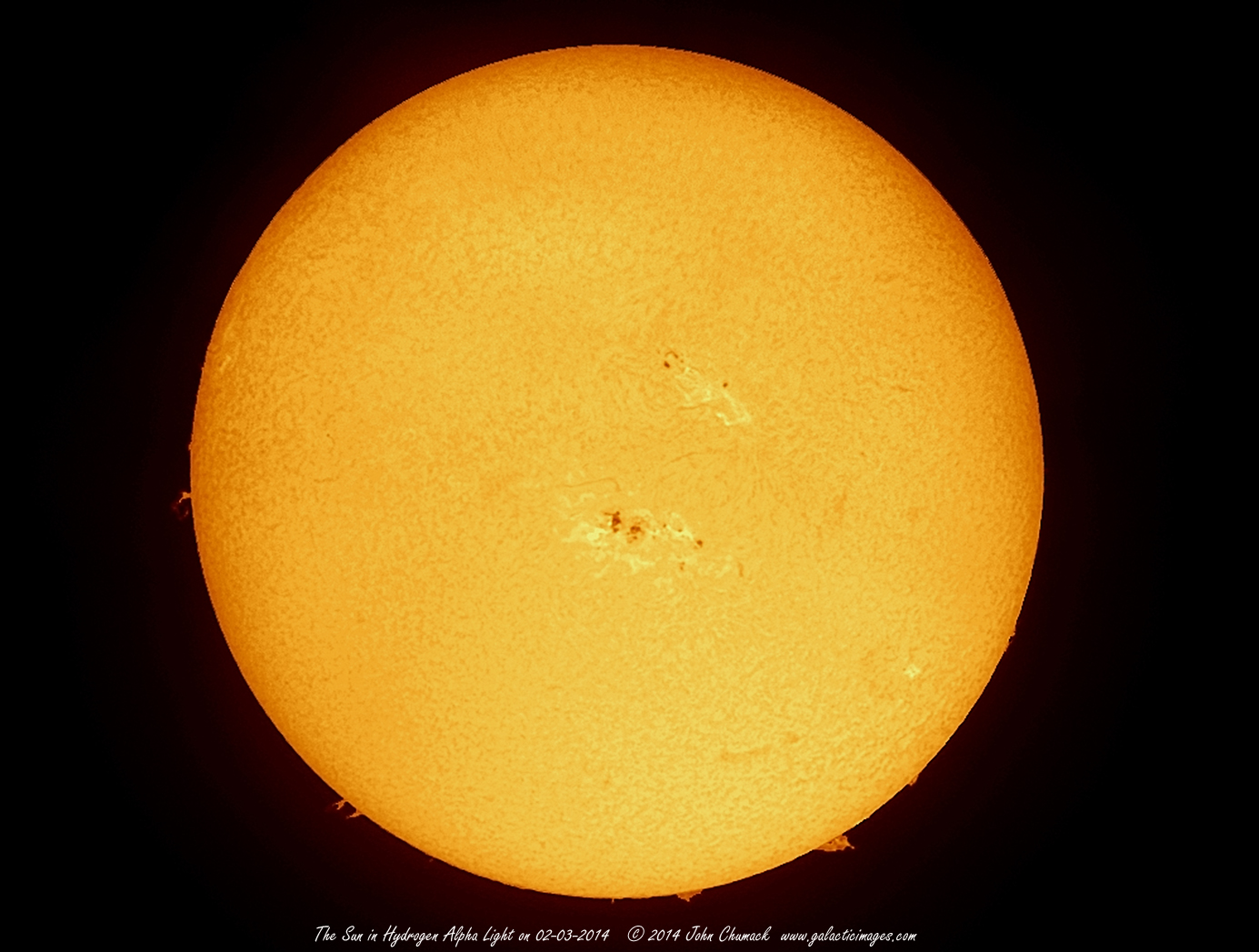
A giant sunspot group takes center stage in these stunning images taken by avid sky photographer John Chumack.
"The massive sunspot AR 1967 is now wider than the planet Jupiter and is very active," Chumack told Space.com in an email on Feb. 4. "Yesterday no less than seven M-class solar flares have erupted from this region."
The sunspot group AR 1967 has continued to unleash several solar flares as it makes its two-week trek across the face of the sun, as seen from Earth. During its last rotation in January, the sunspot group was known as AR 1944 and fired off the first major sun storm of 2014 - an X-class solar flare - in January. X-class flares are the strongest solar storms the sun experiences, with M-class events registering as medium-strength solar events.
John Chumack captured three images of the giant sunspot on Feb. 3 from his backyard in Dayton, Ohio. Two full-disk images are featured: The first appears in hydrogen alpha light (Lunt 60mm/50 F Ha Scope, DMK 31AF04 Camera 1/436 second exposure, 720 frames Stacked), followed by an image of sun in white light from the use of Baader Solar Filter Film (Baader Solar Filter Film, 6" cave reflector, Canon Rebel Xsi, DSLR, 1/2000 second exposure, ISO 400). Chumack also sent Space.com a stunning close up shot of the sunspot group in hydrogen alpha light (Lunt 60mm/50 F Ha Scope, DMK 21AF04 Camera, 2x barlow 1/60 second exposure, 720 frames Stacked).

Residing at the heart of the solar system, the sun is among more than 100 billion stars in our host galaxy, the Milky Way. Approximately one million Earths could fit inside the sun, as it holds 99.8 percent of our solar system’s mass. Nuclear reactions bring core sun temperatures to more than 27 million degrees Fahrenheit (15 million degrees Celsius). The visible part of the sun is about 10,000 degrees F (5,500 degrees C).

Sunspots are typically cooler regions that reach about 3,800 degrees Kelvin (6,400 degrees Fahrenheit, or 3,500 degrees Celsius). While this is much cooler than the rest if the sun, a single sunspot is still 10 times brighter than the full moon. By keeping track of sunspots, scientists can measure the solar activity and space weather. These dark, active areas on the surface of the sun are the result of an interaction of plasma with the sun's magnetic field—mostly occurring in two mid-latitude bands on either side of the sun's equator.
The sun is currently in an active phase of its 11-year solar weather cyle. The current cycle, known as Solar Cycle 24, was expected to peak in late 2013.
Get the Space.com Newsletter
Breaking space news, the latest updates on rocket launches, skywatching events and more!
Warning: Never look directly at the sun through binoculars, telescopes or with your unaided eye. Severe eye damage, and even blindness, can result. Astronomers use special filters to safely observe the sun and protective glasses are required for solar eclipse viewing.
To see more amazing night sky photos submitted by Space.com readers, visit our astrophotography archive.
Editor's note: If you have an amazing night sky photo you'd like to share for a possible story or image gallery, please contact managing editor Tariq Malik at spacephotos@space.com.
Follow Space.com on Twitter @Spacedotcom. We're also on Facebook & Google+. Original story on Space.com.

Join our Space Forums to keep talking space on the latest missions, night sky and more! And if you have a news tip, correction or comment, let us know at: community@space.com.
Nina Sen is a freelance writer and producer who covered night sky photography and astronomy for Space.com. She began writing and producing content for Space.com in 2011 with a focus on story and image production, as well as amazing space photos captured by NASA telescopes and other missions. Her work also includes coverage of amazing images by astrophotographers that showcase the night sky's beauty.
